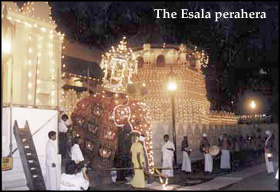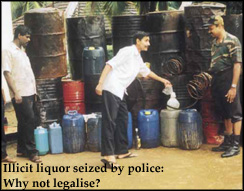
16th July 2000
Front Page|
News/Comment|
Editorial/Opinion| Business|
Sports|
Sports Plus| Mirror Magazine

![]()

- Sunshine over moonshine
- Bathing and body washing - Taste of Sinhala
- Godage – his silent service - Kala Korner - by Dee Cee
- Stefan Milenkovich and Rohan de Silva back again
- Two Times Two is what?
- Welsh language is my world
- The fall of rice
- The Professor and the madman
- Teacher, cut that cane
- Hinduism and Buddhism — a view from afar
- Health Ministry and the iron canard
- 'Pol' polls: does coconut oil cause artery-clogging?
- News 100 years ago
- My life is rich
- Snoopy in court
- St. Patrick's 150 years old
- Damning Israel on a Saturday afternoon - Thoughts from London
- The day of the first discourse
- Colours of love and life
- Record bar nuisance
- Letters to the editor








Sunshine over moonshine
A new study reveals that kasippu is as pure as any other liquor, has less alcohol content than arrack and doesn't give a hangover
By Feizal Samath
The findings of a new Sri Lankan sur-vey on alcohol have stumped re-searchers — illicit liquor or kasippu is, contrary to a long-held belief, as pure as legal liquor, has less alcohol content and doesn't give a hangover.
"The data is mind boggling. Whoever thought kasippu would be as
clean as arrack, Sri Lanka's legal alcohol beverage," said Dr. Ranil
Abeysinghe, a member of the research team and chief of the  Department
of Psychiatry at the University of Peradeniya.
Department
of Psychiatry at the University of Peradeniya.
But he acknowledged that the survey-part of the data is to be published in the next few weeks- would run into severe criticism from anti-alcohol lobbyists who, amongst other issues, blame the police for not controlling the proliferating number of illicit hooch joints in Sri Lanka.
The countrywide research carried out by five social studies graduates however confirmed the view that kasippu is the cheapest form of liquor, freely available and the number one cause of a growing number of alcohol-related deaths.
The survey found that while 70 to 80 per cent of the country's alcohol drinkers drank mostly illicit liquor - with the balance consuming toddy, arrack, beer or stout - what was worrying was the large quantities of kasippu taken because it is cheap.
The team found that in the small town of Thotalanga, drinkers guzzled 240 litres of beer (with an alcohol content of 4.1-4.6 per cent), 260 litres of arrack (32 per cent), 450 litres of toddy (four per cent) and 750 litres of kasippu (22 percent) daily.
According to these trends, the absolute alcohol consumed per day through kasippu was 165 litres, arrack - 83.2 litres, toddy -18 litres and beer - 11 litres.
Sociologists have blamed problems like poverty and suicides on alcohol abuse amongst the poor in the rural countryside. Sri Lanka's suicide rate - an average 27 per day - is among the highest in the world, while health experts say the cirrhosis rate among men is also another first in the world.
The survey launched a year ago, came after Peradeniya researchers studying hospital trends in 1998 found that 70 per cent of the admissions at the hospital were due to illnesses like cirrhosis or pneumonia caused through kasippu addiction.
"We found that there was a basic shift in drinking patterns to illicit liquor from arrack and toddy in 1989 and 1990 mainly due to an increase in the price of arrack at that time. As arrack prices went up — due to higher taxes — drinkers moved to the illegal segment of the market," Dr. Abeysinghe said in an interview.
He blames poor government policies for increased kasippu consumption. While all other alcoholic beverages like arrack, toddy and beer are licensed and the highest taxed items by the government, kasippu escapes the net and as a result of coming cheaper to the user, is consumed in larger quantities.
But Dr. Abeysinghe notes that high consumption is also due to the surreptitious manner in which drinkers are forced to consume kasippu. "They go to an illegal joint in the village or town, quickly gulp a drink given in a small sili sili bag from the local vendor, throw away the bag and then go away. There is no social drinking like in the case of other alcohol," he added, conceding that his comments could fuel criticism from non-governmental agencies working in the field of tobacco and alcohol abuse.
Alcohol abuse experts say illicit liquor is adulterated, can kill and is the number one menace in the country and could be wiped out if the police did their duty. "I don't know about this research but the legal liquor industry is so powerful that they could even fund such research to show that the liquor problem is mainly to do with the illegal, adulterated stuff," noted an anti-alcohol official.
The official also expressed doubts as to whether the data collected was comprehensive enough to make conclusions.
On the other hand, alcohol industry officials claim, the government is barking up the wrong tree in putting all types of liquor in one basket and imposing regulations like the ban on advertising. "They should be going after the illicit liquor barons. That is where abuse takes place. We are a legal industry and pay the highest rate of taxes," an industry official explained.
Last year the advertising, promotion and sports sponsorship of tobacco and alcohol products were banned as part of wide-ranging recommendations of a Presidential Task Force on Tobacco, Alcohol and Illicit Drugs under a national policy aimed at cutting consumption, particularly amongst youth, of harmful substances.
The government, accepting all the recommendations, decided to bring the necessary legislation to Parliament. But industry protests and other problems have held up the proposed law.
The three-month study in March last year was conducted in the towns of Thotalanga and Ja-ela, the rice-growing areas of Anuradhapura and Dambulla in the north central region and Hatton, a tea-growing area in the central hills. The five researchers lived in these areas during the period of the survey, drinking and socializing with residents on the pretext of working in the same locality.
The team also collected kasippu samples, which were sent to laboratories for testing. Of the 27 kasippu samples tested, only two were found to contain impurities. "Even these were not toxic. None of the kasippu drinkers reported getting a hangover. In fact at Thotalanga, those who drank kasippu at night woke up at 4 a.m. and made their way to the illegal joint for another shot," Dr. Abeysinghe said, noting that the kasippu trade worked round the clock.
Sugar and yeast go into the manufacture of kasippu though brewers sometimes use cement or urea to increase the "kick", the study found. Occasionally there is a dead rat in the kasippu vat as a result of it straying into storage tanks, attracted by the pungent smell of the liquor.
Brewers also make fruit kasippu - liquor mixed with orange peel and some coke, giving it a nice smell and colour. This costs higher than the normal kasippu bottle, which sells between Rs. 40 and Rs. 60. In comparison, the cheapest arrack is Rs. 240 per bottle while beer is around Rs. 50 a bottle. The cheapest liquor is toddy at about Rs. 15 per bottle but low in alcohol content for kasippu drinkers.
The survey found that kasippu joint owners had a close nexus with police and politicians and got off with small fines or bribes, whenever raids are conducted. At Thotalanga, researchers saw police walk into illicit liquor joints and collect money from the vendors. Illicit liquor joints are tipped off in advance by a "friendly cop" before a police raid is conducted. Fines or jail terms are small.
Dr. Abeysinghe said the first report which he was presenting on the "urban poor drinking classes" based on the Thotalanga data, would also include a chapter on the evolution of a drinker. "Normally a consumer starts with arrack, then switches to kasippu because it is cheap. He stays with kasippu because he is able to drink large quantities," he added.
The illicit liquor problem is not so bad on tea estates, the survey found. In the Hatton tea region, which came under the survey, estate workers drank arrack and in small quantities due to the cost. Kasippu vendors, it was found, had been unable to penetrate the estate sector like other areas.
Ja-ela town was the main manufacturing and distribution base for the Colombo district. There was also a thriving cottage industry in illicit liquor there. At one grocery store suspected of selling sugar to kasippu brewers, a lorryload of sugar is unloaded everyday on the pretext of lucrative sugar sales!
Dr. Abeysinghe, while acknowledging that solutions to alcohol abuse are hard to find, believes that steps should be taken to legalise kasippu and bring it into the legal net. "Kasippu drinking in Sri Lanka is similar to what wine drinking is in France - part of the culture. Hide it and it becomes popular underground."
The psychiatrist chief said however that two other colleagues at the university involved in the same research project, are likely to differ with his views on illicit liquor.
"I must say I have strong, rather controversial views on illicit liquor. I believe that kasippu must be legalized and made an alcoholic beverage like any other drink. My two colleagues may have different views," he added.
Dr. Abeysinghe said his two colleagues, who were not immediately available for comment, would present two other reports on the extensive data collected under the survey.
![]()
Front Page| News/Comment| Editorial/Opinion| Plus| Business| Sports| Sports Plus| Mirror Magazine
Please send your comments and suggestions on this web site to

